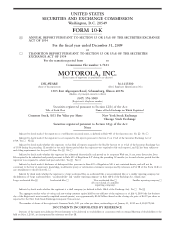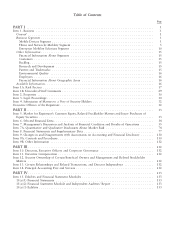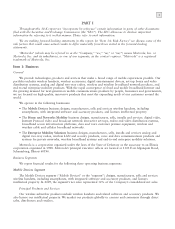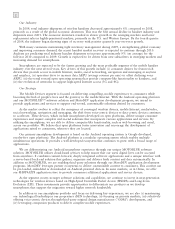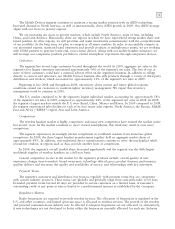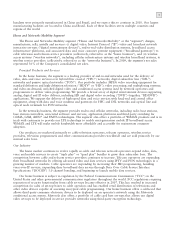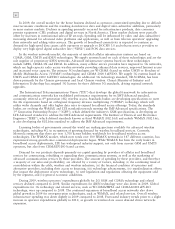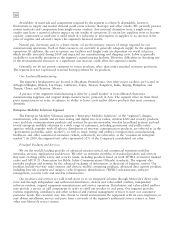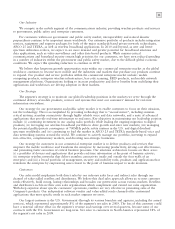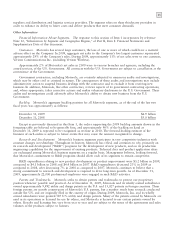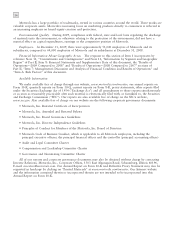Motorola 2009 Annual Report Download - page 14
Download and view the complete annual report
Please find page 14 of the 2009 Motorola annual report below. You can navigate through the pages in the report by either clicking on the pages listed below, or by using the keyword search tool below to find specific information within the annual report.
6
In 2009, the overall market for the home business declined as operators constrained spending due to difficult
macroeconomic conditions and the resulting slowdown in data and digital video subscriber additions, particularly
in more mature markets. Declines in spending primarily occurred for infrastructure products, data consumer
premise equipment (CPE) products and digital set-tops in North America. These market declines were partially
offset by increases in international sales of IP set-tops. Spending will be influenced by video and data subscribers’
increasing demand for advanced video platforms and applications, as well as from telecom operators’ upgrading
their networks and adding video services. The growth of broadband connectivity is expected to continue as
demand for high-speed data causes cable operators to upgrade to DOCSIS 3.0 and telecom service providers to
deploy very high speed digital subscriber line (‘‘VDSL’’) and PON data services.
In the wireless networks market, the majority of installed cellular infrastructure systems are based on
CDMA, GSM, UMTS and iDEN technologies. We supply systems based on each of these technologies and are the
sole supplier of proprietary iDEN networks. Advanced infrastructure systems based on these technologies
include GPRS, CDMA-1X and EDGE. In addition, many cellular service providers have migrated to 3G networks,
which are high-capacity radio access wireless networks providing enhanced data services, improved Internet access
and increased voice capacity. The primary 3G technologies are W-CDMA (based on either UMTS or Freedom of
Mobile Multimedia Access (‘‘FOMA’’) technologies) and CDMA 2000 1xEVDO. We supply 3G systems based on
UMTS and CDMA 2000 1xEVDO technologies. An additional 3G technology standard, TD-SCDMA, has been
driven primarily by the Chinese government and local Chinese vendors. China’s Ministry of Industry and
Information Technology has assigned 3G licenses for three different 3G standards, driving regional network
upgrades.
The International Telecommunications Union (‘‘ITU’’) that develops the global framework for information
and communications networks has established performance requirements for its IMT-Advanced standard,
commonly referred as 4th generation (4G) wireless access. Standards bodies are developing specifications to meet
the 4G requirements based on orthogonal frequency division multiplexing (‘‘OFDM’’) technology which will
utilize wider channels and offer higher data rates to expand broadband access offerings. Today, the standards
bodies are evolving the WiMAX and LTE standards towards meeting the IMT-Advanced specifications. The
3rd Generation Partnership Project (‘‘3GPP’’), which defined the industry’s GSM specifications, is developing an
LTE-Advanced standard to address the IMT-Advanced requirements. The Institute of Electrical and Electronics
Engineers (‘‘IEEE’’), which defined standards known as fixed WiMAX (802.16d) and mobile WiMAX (802.16e),
is also developing the 802.16m standard to address the IMT-Advanced requirements.
Licensing bodies of governments around the world are making spectrum available for advanced wireless
technologies, including 4G, in recognition of growing demand for wireless broadband services. Currently,
Motorola estimates that there are over 1,700 license holders worldwide for broadband wireless access
technologies. The WiMAX market, which now totals over 500 WiMAX networks in 147 different countries, has
experienced strong growth since commercial deployments began. While WiMAX has been the early leader in
broadband access deployments, LTE has widespread industry support, not only from current GSM and UMTS
operators, but also from CDMA/EV-DO based carriers.
Demand for our products depends primarily on capital spending by providers of cellular and broadband
services for constructing, rebuilding or upgrading their communications systems, as well as the marketing of
advanced communications services by those providers. The amount of spending by these providers, and therefore
a majority of our sales and profitability, are affected by a variety of factors, including: (i) the continuing trend of
consolidation within the cable, wireline and wireless industries, (ii) the financial condition of operators and
alternative providers, including their access to financing, (iii) technology advancements, (iv) standardization efforts
that impact the deployment of new technology, (v) new legislation and regulations affecting the equipment sold
by the segment, and (vi) general economic conditions.
During 2009, wireless operators’ expenditures globally for 2G GSM and CDMA technology and related
services declined compared to 2008. Similar expenditures for iDEN technology were also down in 2009. Global
expenditures for 3G technology and related services, such as W-CDMA/HPSA and CDMA2000/1xEV-DO
technology, were up compared to 2008. The continued expansion of broadband access networks also drove
global growth in 2009 for next-generation technologies, such as WiMAX, and related services. Overall wireless
infrastructure spending was down slightly in 2009 compared to 2008. Forecasted industry trends point to a slight
increase in operator expenditures globally in 2010, as growth in wireless data access demand drives networks
expansion.





